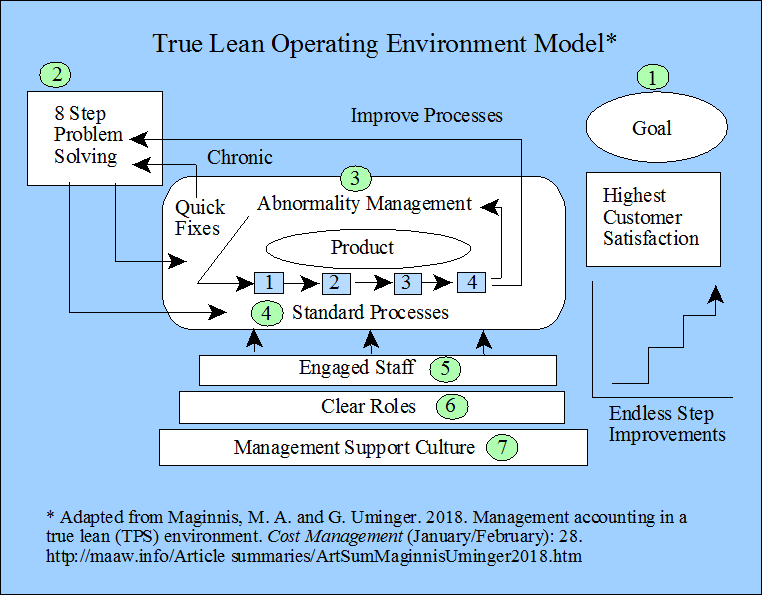
Summary by James R. Martin, Ph.D., CMA
Professor Emeritus, University of South Florida
JIT and Lean Enterprise Main Page |
Lean Accounting Main Page
The Lean Systems Program developed at the University of Kentucky coined the term "True Lean" as a synonym for the Toyota Production System. The purpose of this article is to describe the operational conditions and methods practiced at Toyota that define a true lean system, and some of the lean accounting practices that are only applicable in such a system.
True Lean
True Lean is defined as "the group by themselves, using systematic problem solving to improve the work they do, towards the achievement of the company's targets and goals, when and only when the company culture is the reason the improvement occurs." There are seven conditions in a true lean environment that include the following:
1. The goal is to achieve the highest customer satisfaction possible using continuous improvement,
2. A methodology to address and eliminate waste. An eight-step problem-solving method,
3. Abnormality management including quick fixes (containment) and eliminating chronic problems,
4. Standard (i.e. stable) processes that reveal problems quickly,
5. Engaged staff with a supportive environment where they self-manage their work,
6. Team members have clear roles under both normal and abnormal circumstances, and
7. A strong and consistent supportive management culture.

Abnormal conditions involve some form of waste (7 types of muda) including waiting, over processing, rework, motion, overproduction, inventory and transportation. True lean includes a high level of self-management that is a prerequisite for lean accounting to be effective, i.e., true lean accounting.
Preconditions for True Lean Accounting Practices
The applicable accounting practices are determined by the degree of self-management. There are four key criteria that drive true lean accounting:
1. A connected flow,
2. Operational control, i.e., where the team members doing the work can see and correct abnormalities,
3. Continuous self-improvement (kaizen) activities in safety, quality, and efficiency, and
4. An environment of trust including a problem-solving mentality at all levels of management.
A true lean accounting system includes four categories:
1. Senior management support, i.e., recognition that self-management is key, that the people doing the work are in the best position to improve the process. Accounting supports the team members by providing macro-trend reporting of costs that are drifting or not meeting targets. Traditional standard costing and cost variances are not needed.
2. Operations cost management, i.e., providing only controllable costs relative to each level, (e.g., supply, usage, scrap), ensuring a key performance indicator structure (e.g., visual control boards), and providing information and practices that support self-management. Product cost includes the product development phase (life-cycle costs) and the production phase (where the emphasis is on controllable costs). Variances are identified and managed at the point of occurrence, eliminating the need for traditional variance reports.
3. Core internal accounting, i.e., financial statements, asset management, accounts payable, accounts receivable, etc.
4. New product development, i.e., target costing, cost planning, price studies, etc.
Conclusion
A "True Lean Environment" establishes the basis for a simplified lean accounting system that shifts the emphasis from traditional control to self-management at the process level where the work is performed.
__________________________________________
Related summaries:
Baggaley, B. and B. Maskell. 2003. Value stream management for lean companies, Part I. Journal of Cost Management (March/April): 23-27. (Summary).
Baggaley, B. and B. Maskell. 2003. Value stream management for lean companies, Part II. Journal of Cost Management (May/June): 24-30. (Summary).
Brosnahan, J. P. 2008. Unleash the power of lean accounting. Journal of Accountancy (July): 60-66. (Summary).
De Luca, M. 2018. How lean accounting promotes lean in the organization. Cost Management (January/February): 21-26. (Summary).
Fullerton, R. R. 2003. Performance measurement and reward systems in JIT and non-JIT firms. Cost Management (November/December): 40-47. (Summary).
Fullerton, R. R. and C. S. McWatters. 2002. The role of performance measures and incentive systems in relation to the degree of JIT implementation. Accounting, Organizations and Society 27(8): 711-735. (Summary).
Kapanowski, G. 2016. Lean fundamentals for accountants. Cost Management (January/February): 5-14. (Summary).
Kapanowski, G. 2017. Lean accounting. Cost Management (January/February): 37-41. (Summary).
Kristensen, T. B. and P. Israelsen 2012. Management accounting system problems in context of lean: Development of a proposed solution. In Mitchell, F., H. Norrreklit and M. Jakobsen, eds. 2012. The Routledge Companion to Cost Management. Routledge Companions in Business. (Summary).
Martin, J. R. Not dated. What is lean accounting? Management And Accounting Web. Lean Accounting
Martin, J. R., W. K. Schelb, R. C. Snyder, and J. C. Sparling. 1992. Comparing the practices of U.S. and Japanese companies: The implications for management accounting. Journal of Cost Management (Spring): 6-14. (Summary).
Maskell, B. H. and B. L. Baggaley. 2006. Lean accounting: What's it all about? Target Magazine 22(1): 35-43. (Note).
Patell, J. M. 1987. Adapting a Cost accounting system to just-in-time manufacturing: The Hewlett-Packard Personal Office Computer Division. Accounting & Management Field Study Perspectives, edited by William J. Bruns, Jr. and R. S. Kaplan. Harvard Business School Press: 229-267. (Summary).
Pickering, M. 2017. Implementing lean management reporting in lean enterprises. Cost Management (January/February): 28-36. (Summary).
Toyota Public Affairs Division and Operations Management Consulting Division. 1998. The Toyota Production System: Leaner Manufacturing for a Greener Planet. The Toyota Motor Corporation. (Summary).